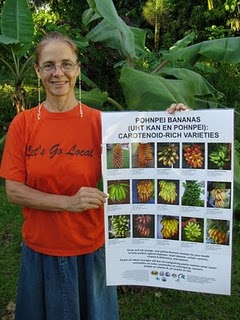- Agriculture 101: A graphic novel. Am I the only one who thinks novels aren’t necessarily true? First installment.
- Bioversity has a bunch of factsheets on Nutritious Underutilized Species.
- Why is a cacao tree not like an ATM? Because the ATM still pays out when its hot.
- Speaking of which, big long thought piece on Food Security and Climate Change.
- Giant pumpkins; not much diversity here, except in the agronomic approaches.
- Better access to markets may threaten specialist smallholder farmers. The case of Namibia.
- Ancient Roman ate lots of C4 photosynthesiser: millet!
- Wake up and smell the lack of green coffee.
- A couple of wannabe Mexican industrial crops get some exposure.
Nibbles: Swaziland, Traditional Knowledge, Climate change, Apples, Winged beans, Ambakkadan Cassava
- Queen Mother Ntombi Indlovukazi of Swaziland receives the FANRPAN 2011 Food Security Policy Leadership Award. Her son’s a caution too.
- Summaries of presentations at Informing International Policy on Traditional Knowledge, Mexico 2011.
- CGIAR book on “climate-proofing” crops critical to food security in the developing world.
- Happy Birthday to the McIntosh apple.
- Rhizowen’s winged beans fail to take flight.
- Sharefair hears how women farmers in India resurrected a favoured cassava.
- Sharefair hears dream-team pitch on frike, or as we prefer to say, freekeh.
Brainfood: Rice yield, Carrot evaluation, Caper chemistry, Rice fortification, Range shifts, Baobab, Tunisian thyme, Drought-tolerant rice
- Rice yields and yield gaps in Southeast Asia: Past trends and future outlook. If average farmers became like best-yielding farmers that would meet 2050 needs, except in the Philippines, where some more structural stuff is needed.
- Method of evaluating diversity of carrot roots using a self-organizing map and image data. The sound you hear is that of butterflies being broken on wheels.
- Bioactive compounds from Capparis spinosa subsp. rupestris. Are pretty much the same as those in subsp. spinosa.
- Constitutive Overexpression of the OsNAS Gene Family Reveals Single-Gene Strategies for Effective Iron- and Zinc-Biofortification of Rice Endosperm. So that’s a good thing, right?
- Analysis of climate paths reveals potential limitations on species range shifts. Corridors not the answer. Or not the only answer. Or not the full answer.
- An updated review of Adansonia digitata: A commercially important African tree. Do baobab scientists not sometimes long for the Time Before Reviews, when they actually, you know, did stuff?
- Genetic diversity, population structure and relationships of Tunisian Thymus algeriensis Boiss. et Reut. and Thymus capitatus Hoffm. et Link. assessed by isozymes. Dad, what’s an isozyme? Ah, son, it’s a thing people used in the Time Before DNA. The two species are different, they need to be managed in different ways.
- Potential Impact of Biotechnology on Adaption of Agriculture to Climate Change: The Case of Drought Tolerant Rice Breeding in Asia. Kinda pointless: “in severe drought both the [drought tolerant] and the conventional varieties were either not planted or, if planted, did not yield”.
Remembering Lois Englberger
 Very sad news. Lois Englberger, nutritionist and fighter for the dietary benefits of agricultural biodiversity, has died. We will remember her dedication, her helpfulness, and her cheerful personality. You can help to support her work with the Island Food Community of Pohnpei with a donation.
Very sad news. Lois Englberger, nutritionist and fighter for the dietary benefits of agricultural biodiversity, has died. We will remember her dedication, her helpfulness, and her cheerful personality. You can help to support her work with the Island Food Community of Pohnpei with a donation.
Nibbles: Moringa, Fungi, Blue potatoes, GRAIN, Nutrition, Maize Day, Sorghum research
- Mexico embraces moringa against malnutrition.
- Get your mushroom spores here. (You’ll need something for the headache the page induces.)
- Scientist Gardener discovers blue potato chips at altitude.
- GRAIN gets altNobel. It’s not the winning. It’s the being nominated.
- Bioversity stuns world with nutrition strategy. While Jess does poo.
- Damn, looks like we missed National Maize Day again.
- How your United Sorghum Checkoff dollars are being spent.